|
The earliest ant descriptions probably are those of Monomorium
pharaonis and Monomorium
salomonis by Carl Linnaeus in 1758.

|
 |
 |
. |
|
Petrus Forskål (or Forsskål) joined an expedition
to the Near East in 1761, working as a naturalist and collected
extensively in Egypt and Saudi Arabia. His Flora Aegyptiaco-Arabica
was published posthumously.Born 11.i.1732, died in Yemen, 11.vii.1763
See http://en.wikipedia.org/wiki/Peter_Forsskal
|
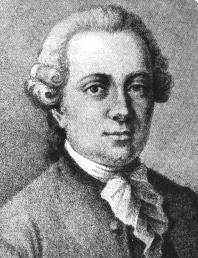 |
|
Ants he collected were among the identifications in
Forskål (1775) Descriptiones animalium, avium, amphibiorum, piscium,
insectorum, vermium; quae in itinerae orientali observavit Petrus
Forskål. Published post-mortem with editing by Carsten Niebuhr, the
sole survivor of the expedition. The full text is available at http://www.biodiversitylibrary.org/page/2088067
Forskâl's ant records are shown right. Bolton (1995: 190ff) listed them
as incertae sedis from Egypt. Only one of the species was
actually given by Forskâl as from an Egyptian location, i.e. Alexandria.
|
Forskål's ant descriptions (cited as undefinable by
Bolton, 1995) are at 
20. Formica salomonis (Linn.; Forskål (1775: 85, worker)
21. Formica edax Forskål (1775: 85, worker)
22. Formica maligna Forskål (1775: 84, worker
23. a) Formica animosa Forskål (1775: 85, worker)
23. b) Formica insultans Forskål (1775: 85, worker). .
Other incomprehensible records are at  . His journey was mapped on . His journey was mapped on 
Emery (1892b) in his - Note sinonimiche sulle formiche. Boll.
Soc. Entomol. Ital., 23, 159-167 -  gave synonymies for gave synonymies for
20. Formica salomonis (Linn.) = Aphaenogaster barbarus;
an incorrect determination of Monomorium
salomonis, common in Alexandria;
21. Formica edax = a small Pheidole worker &
soldier, dubiously ["è sense dubbio"] = Ph. megacephala. We
feel the likelihood from Forskål' s description is that this was Pheidole fervens
(reddish colour with wholly yellowish antennae and legs, head rufous;
body hairy)
22. Formica maligna (from Arabia or Egypt) black and with a
single pedicel segment, pungent and from a dead scorpion = Pachycondyla
sennaarensis.
|
|
Bolton (1995: 190 ff) listed some Forskål names as
identified by Fabricius, apparently twice, in 1775 and again in 1793 -
example below; also Pheidole
fervens synonym edax.
 Formica
aegyptiaca Fabricius (1775: 393, worker) - undefinable by
Bolton (1995: 191) - possibly Crematogaster
aegyptiaca Formica
aegyptiaca Fabricius (1775: 393, worker) - undefinable by
Bolton (1995: 191) - possibly Crematogaster
aegyptiaca
Formica binodis of Forskål, from Egypt = Messor binodis
|
 |
G.A. Olivier (1792), in his
contribution to the Encyclopédie Méthodique. Histoire Naturelle.
Insectes, vol 6, included the species of Fabricius and others -
possibly Crematogaster aegyptiacus - Formica
aegyptiaca  ; Messor arenarius
- as Formica arenaria ; Messor arenarius
- as Formica arenaria  ; Messor barbarus - as Formica
barbara ; Messor barbarus - as Formica
barbara  ; Messor barbarus
binodis - as Formica binodis ; Messor barbarus
binodis - as Formica binodis  ; Camponotus maculatus or aegyptiacus
- Formica maculata ; Camponotus maculatus or aegyptiacus
- Formica maculata  ; Monomorium pharaonis
- as Formica pharaonis ; Monomorium pharaonis
- as Formica pharaonis  ; Monomorium salomonis
- Formica salomonis ; Monomorium salomonis
- Formica salomonis  ; and Cataglyphis
viatica - as Formica viatica ; and Cataglyphis
viatica - as Formica viatica  . .
|
 |
Pierre Latreille (1802) gave a few
from Egypt, mainly the Fabricius species but also the new description
of Camponotus
cruentatus - as Formica cruentata  . .
|
 |
|
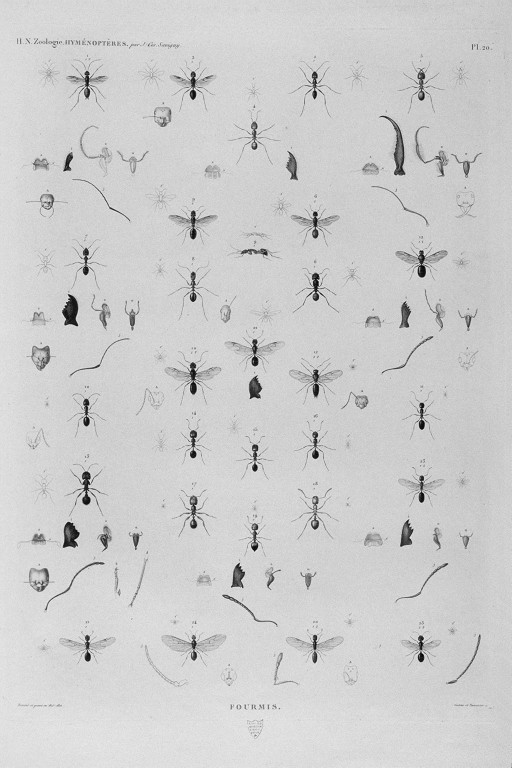 Jean Victor Audouin & Jules-César Savigny and
the great Egyptian Expedition. Jean Victor Audouin & Jules-César Savigny and
the great Egyptian Expedition.
In 1802, Napoleon ordered the Imperial Press to begin
publication of the visual record set down by the Egyptian expedition of
1798. Initially, the work was published in instalments between 1809 and
1829. Four hundred copper engravers worked for some twenty years on the
Description. The resulting monumental work comprises ten folio volumes
with 837 copper engravings and 3000 illustrations edited by the best
minds in France (a complete facsimile edition of the Description de
l'Egypte, was published in 1997 by Benedikt Taschen GmbH, Cologne).
On insects at least, Jules-César Savigny engraved most
of the plates; ants were illustrated on Planche 20, p 202.
Jean Victoire Audouin (April 27, 1797 - November 9,
1841) was a French naturalist, entomologist and ornithologist. Audouin
was born in Paris and studied medicine. In 1824 he was appointed
assistant to Pierre André Latreille as Professor of Entomology at the
Muséum National d'Histoire Naturelle, and succeeded him in 1833. In
1838 he became a member of the French Academy of Sciences.
Audouin, J.V. 1826. Explication sommaire des planches
(Mollusques - Annelides - Crustacés - Arachnides - Insectes -
Echinodermes - Zoophytes - Ascidies - Polypes - Hydrophytes - Oiseaux)
dont les dessins ont été fournis par M.J.C. Savigny, pour l'histoire
naturelle de l'ouvrage (offrant un exposé des caractères naturels des
genres avec la distinction des espèces (Polypes, pp. 225-244). In
Description de l'Égypte, ou, Recueil de observations
et des recherches qui ont été faites en Égypte pendant l'expédition de
l'armée française, publie par les ordres de Sa Majesté l'empereur
Napoleon le Grand. E.F. Jomard, ed., Imprimerie imperiale, Paris, 339
pp. Histoire Naturelle: text: 1824-1829; plates: 1826. Text: 6 volumes,
octavo. 1 folding engraved plate, 4 folding letterpress tables; Plates:
large folio (format Jesus), 244 engraved plates jpg extract.
Léon Dufour (1862), described Cataglyphis
savignyi, Savignyi specimens 1 and 2. Dufour refers to
searching the literature of the prominent authors of preceding years
but it seems none of the others were described or identified. There
appears also that there was an unpublished monograph by Dufour *, as
Nylander (1856b) referred to it when he gave a description of Camponotus
cruentatus opacus, which he said was identifiable as Savignyi's
specimen 7.
* Mayr (1861: 16) has a literature list which includes - "Dufour (Leon),
Annales de la Société entomologique de France V" -
this was not listed by Bolton (1995); Mayr listed "Camponotus
marginatus", as from Egypt.
Léon Jean Marie Dufour (1780-1865), was a physician in
Saint-Sever, Landes, Gascogne, France, who published 232 articles on
arthropods, particularly it seems on Coleoptera [see http://www.saint-sever.fr/tourisme_hommes_Leon_Dufour.htm]
Our suggested identifications of the ants shown on
Savigny's Plate 20 our on Savigny
Plate XX
|

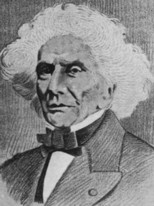
|
|
Frederick Smith (1805-1879) - His "Catalogue"
(1858b) included his description of Camponotus sericeus (p 30)
- as Formica obtusa  . but had no other
records from Egypt. Smith's descriptions, however, were in a simplistic
inadequate style no better than those of Linnaeus a century earlier. . but had no other
records from Egypt. Smith's descriptions, however, were in a simplistic
inadequate style no better than those of Linnaeus a century earlier.
Frederick Smith (1805-1879) was born in London and trained as a
engraver on steel. He became interested in the habits of Hymenoptera.
In 1850 Smith was appointed as Assistant in the Zoological Department
of the British Museum, and in 1875 became Senior Assistant. His
published works included the Catalogue of the Hymenopterous Insects in
the British Museum (1853-1859), and the Catalogue of the British
Fossorial Hymenoptera (1858). He was President of the Entomological
Society of London in 1862 and 1863.
|
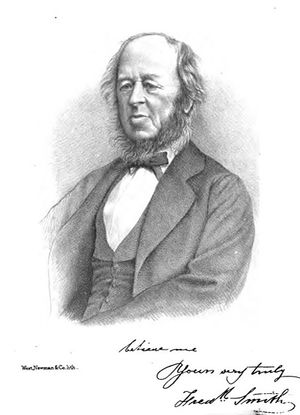
|
|
Gustav Mayr - Mayr appears to have been the first
myrmecologist to approach the task of taxonomy in a way that remains
essentially unchanged to this day. His descriptions are precise and
careful and, in his 1862 paper -  , he
provided dichotomous keys at both Subfamily and Genus levels. , he
provided dichotomous keys at both Subfamily and Genus levels.
Although no collection details are given, he reports
specimens held in the Zoological Cabinets in the Vienna Museum which
originated from Egypt; most being from Sinai Peninsula and collected by
R. von Frauenfeld (* = not by v. Frauenfeld, simply
in Cabinets).
These include *Camponotus maculatus; *Camponotus sericeus;
Cataglyphis albicans; Dorylus (Typhlopone)
helvolus oraniensis; Nesomyrmex angulatus (Leptothorax
angulatus), new species; Tetramorium bicarinatum (T.
guineensis); Pheidole sinaitica, new species; Monomorium
pharaonis, with a full description; *Carebara sicheli, from
White Nile (Sudan); *Crematogaster (Crem.) aegyptiaca, new
species; Crematogaster (Crem.) inermis, new species. In 1866
(Mayr, 1866a) he added Plagiolepis mediterranea, new species.
Mayr, Gustav L. (b. October 12, 1830; d. July 7, 1908) in
Rozzano (close to Milan). In
1863-1882 he was appointed as a college teacher and worked up to
1892 in collaboration with the Museum of Natural History (at that time
"k.k. Hof-Cabinet"), but was not appointed to the Museum; he was a
college teacher ("Realschul-Professor") in Vienna. In 1894 he was
honoured by the title of a "Kaiserlicher Rat" ("Imperial Councillor").
Some of his collection is deposited in the Naturhistorisches Museum
Wien, Austria (NHMW) and some is in the Staatliches Museum für
Tierkunde, Dresden (SMTD). (With thanks to Prof Luitfried v. S.-Plawen
for information).
|

|
|
Francis Walker (1871). A list of Hymenoptera
collected by J.K. Lord, esq., in Egypt, in the neighbourhood of
the Red Sea, and in Arabia 59 pp, London - Cataglyphis
bicoloripes  . .
Collections in Egypt by J K Lord were at - Cairo, Shoobra, Heliopolis,
Red Mountains and Giza Pyramids.
Ants listed were -
- Formica
aequalis Walker (1871: 9, queen) - undefinable by Bolton (1995:
191) - possibly Anochetus
sedilloti

- Cataglyphis
bicoloripes Walker - queen only (Walker, 1871: 10, queen)
[not in Santschi, 1929b] - Agosti (1990: 1495) noted this as species
incertae sedis, as the Walker's description was inadequate and no
specimens could be found in the collection (Natural History Museum,
London)
 . .
- Aphaenogaster
pallescens Walker - unrecognised by Bolton (1995)
 . .
- Camponotus ligniperdus (-a) at Wady Ferran, Mt
Sinai - probably another Camponotus
- Camponotus sericeus at Mt Sinai
- Camponotus pilaeogaster at Wady Ferran
 . .
- Cataglyphis viatica at Wady Amara, Mt Sinai
- Messor structor as Aphaenogaster structor
at Cairo, Wells of Moses
- Monomorium salomonis as Aphenogaster
debilis at Pharaoh's Baths
|

|
|
O. Radoszkowsky (1876  ) Compte-rendu des hymenoptères recueilles
en Egypte et Abyssinie en 1873. Tr. Russ. Entomol. Obshch., 12,
111-150. The specimens from Egypt were collected by Dr Dziedzicki, a
specialist in Diptera, who was a member of a scientific expedition led
by Comte Alexandre Branicki. This includes Cataglyphis argentatus
n sp, also Cataglyphis viatica. Other species in the paper were
from Ethiopia. ) Compte-rendu des hymenoptères recueilles
en Egypte et Abyssinie en 1873. Tr. Russ. Entomol. Obshch., 12,
111-150. The specimens from Egypt were collected by Dr Dziedzicki, a
specialist in Diptera, who was a member of a scientific expedition led
by Comte Alexandre Branicki. This includes Cataglyphis argentatus
n sp, also Cataglyphis viatica. Other species in the paper were
from Ethiopia.
|
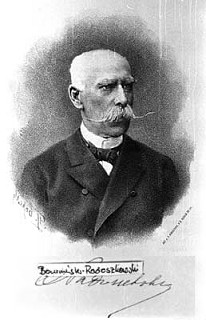 The first page of his
paper gives his title as "Général d' Artillerie". Radoszkowsky, who
gave his address as St Petersburg, described the work as a continuation
of the descriptions of Hymenoptera earlier made by Spinola and Klug. The first page of his
paper gives his title as "Général d' Artillerie". Radoszkowsky, who
gave his address as St Petersburg, described the work as a continuation
of the descriptions of Hymenoptera earlier made by Spinola and Klug. |
Ernest André (1881b  ) reported four species - Cataglyphis
niger (as a new variety of C. viaticus), Paratrechina
longicornis, Messor arenarius (as Aphaenogaster arenaria
Fab) and Pheidole jordanica (as P. sinaitica but
differing) - collected from Alexandria by M Abeille de Perrin at the
start of a journey through Palestine, Lebanon and Syria. ) reported four species - Cataglyphis
niger (as a new variety of C. viaticus), Paratrechina
longicornis, Messor arenarius (as Aphaenogaster arenaria
Fab) and Pheidole jordanica (as P. sinaitica but
differing) - collected from Alexandria by M Abeille de Perrin at the
start of a journey through Palestine, Lebanon and Syria. |
He appears to have published papers on ant
taxonomy from 1874 to 1905, with his collection of specimens being in
the Museum in Paris.
His major work was Species des Hymenoptères d'Europe et d'Algérie
published in sections in 1881-1886, which has keys, descriptions and
numerous illustrations. |
Auguste Forel (1886f: 75) recorded
Cataglyphis bombycinus as Myrmecocystus
bombycinus Roger, from the Oasis de Bahrych and from Harrars, coll.
de Saussure; Cyrenica (Berlin Museum); soldiers from Egypt, Nubia,
coll. de Saussure; also Lepisiota frauenfeldi a variety with
the worker having the metanotum with spines longer than the width
between their bases, from Egypt, collected by M Ehrenberg, Berlin
Museum.
(photo in old age from http://en.wikipedia.org/wiki/Auguste_Forel,
see also http://www.whonamedit.com/doctor.cfm/1480.html)
[Henri de Saussure (1829-1905), grandson of the renowned Swiss
physicist and geologist, Horace-Bénédict de Saussure, was an
entomologist and naturalist specialising in Orthoptera; his collections
of Hymenoptera are in the Nautral History Museum in Geneva (see http://www.ville-ge.ch/musinfo/mhng/page/entocoll.htm#hymenoptere)] |
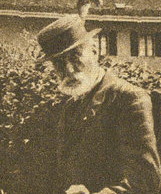 |
Almost forty years after his previous
paper, Mayr (1904b  ) reported
on ants collected in Egypt and the Sudan by the Jãgerskiöld
Expedition of 1901. Most of the ants listed were collected in
Sudan. Those from Egypt were - Monomorium nitidiventre, Monomorium
salomonis, Messor aegyptiacus, Pheidole jordanica
(as Pheidole sinaitica ssp laticeps new ssp), Paratrechina
jaegerskieoldi (as Prenolepis jaegerskioeldi) new species.
He made reference to a one-line entry in his 1893 paper describing ants
collected by Dr Fr Stuhlmann in East Africa, where he listed
"11. M. viaticus Fabr. Cairo" (Mayr 1893: 5) and states the
correct determination was Cataglyphis desertorum (as Myrmecocystus
vaiaticus Fabr. subspec. desertorum Forel. ) reported
on ants collected in Egypt and the Sudan by the Jãgerskiöld
Expedition of 1901. Most of the ants listed were collected in
Sudan. Those from Egypt were - Monomorium nitidiventre, Monomorium
salomonis, Messor aegyptiacus, Pheidole jordanica
(as Pheidole sinaitica ssp laticeps new ssp), Paratrechina
jaegerskieoldi (as Prenolepis jaegerskioeldi) new species.
He made reference to a one-line entry in his 1893 paper describing ants
collected by Dr Fr Stuhlmann in East Africa, where he listed
"11. M. viaticus Fabr. Cairo" (Mayr 1893: 5) and states the
correct determination was Cataglyphis desertorum (as Myrmecocystus
vaiaticus Fabr. subspec. desertorum Forel. |
|
Forel (1907a  ) described
ants from the Hungarian National Museum, including a number collected
by M Biró, on a journey to the Far East. From Egypt were a few species
- Tetramorium simillimum, from Ismailia; Monomorium
salomonis from Alexandria; Monomorium subopacum from Suez; Pheidole
pallidula from Alexandria; and, Crematogaster inermis from
Suez. ) described
ants from the Hungarian National Museum, including a number collected
by M Biró, on a journey to the Far East. From Egypt were a few species
- Tetramorium simillimum, from Ismailia; Monomorium
salomonis from Alexandria; Monomorium subopacum from Suez; Pheidole
pallidula from Alexandria; and, Crematogaster inermis from
Suez.
|
|
Forel (1913d  ) reported Cardiocondyla
nuda v fajumensis from Fajum, coll U Sahlberg; Pheidole
teneriffana from Cairo; Tetramorium sahlbergi from Caiiro; Nesomyrmex
angulatus as Leptothorax angulatus from Luxor; Cataglyphis
isis from Heliopolis; Lasius lasiodes from Fajum; ) reported Cardiocondyla
nuda v fajumensis from Fajum, coll U Sahlberg; Pheidole
teneriffana from Cairo; Tetramorium sahlbergi from Caiiro; Nesomyrmex
angulatus as Leptothorax angulatus from Luxor; Cataglyphis
isis from Heliopolis; Lasius lasiodes from Fajum; |
|
Felix Santschi (1908  ) in only
the second paper in what was an amazingly prolific set of publications
over some thirty years, reported specimens sent to him from Cairo by
his friend M. Borcard - Hypoponera ragusai, Monomorium
bicolor, Monomorium salomonis, Monomorium destructor
(as gracillimum), Crematogaster inermis, Pheidole
teneriffana, Messor barbarus r capitatum var mediorufa
nov, Paratrechina jaegerskioeldi var borcardi nov., Cataglyphis
bicolor, Camponotus maculatus, and Camponotus thoracicus var
xerxes [now Camponotus cognatocompressus, Forel (1904b:
379, all forms, from "Africa"; unavailable name Camponotus rubripes
r cognata var cognatocompressus Forel, 1886f: 151;
raised to species under name xerxes by Pisarski, 1967: 414, but
probably thoracicus (see Santschi, 1938a). ) in only
the second paper in what was an amazingly prolific set of publications
over some thirty years, reported specimens sent to him from Cairo by
his friend M. Borcard - Hypoponera ragusai, Monomorium
bicolor, Monomorium salomonis, Monomorium destructor
(as gracillimum), Crematogaster inermis, Pheidole
teneriffana, Messor barbarus r capitatum var mediorufa
nov, Paratrechina jaegerskioeldi var borcardi nov., Cataglyphis
bicolor, Camponotus maculatus, and Camponotus thoracicus var
xerxes [now Camponotus cognatocompressus, Forel (1904b:
379, all forms, from "Africa"; unavailable name Camponotus rubripes
r cognata var cognatocompressus Forel, 1886f: 151;
raised to species under name xerxes by Pisarski, 1967: 414, but
probably thoracicus (see Santschi, 1938a).
Santschi himself was described by Forel (1904c) as "M.
le Dr. Santschi, de Lausanne, établi comme médecin dans la ville sainte
des Arabes de Tunisie" and seems to have lived mainly in Kairouan,
Tunisia, around where he made personal studies and collections of
primarily desert ants. Kairouan, now known as Al Qayrawân, is also
called the City of 100 Mosques. The earliest of his own reports of
personal collections in Kairouan is recorded as January 1906 (Santschi,
1907), although Forel (1905b) described Monomorium santschii
[as Wheeleria santschii] as collected by Santschi at Kairouan
on 19 August 1903, and Solenopsis santschii as collected in a
Kairouan street on 1 August 1903. In his 1907 paper, Santschi dedicated
the newly named species Leptothorax foreli to Professor A.
Forel, "who initiated my interest into the so interesting study of
ants" [my translation]. What appears to be his signature (right) is
written on the copy of his 1932a paper that has been scanned for the
Antbase website. Photo below.
|

|
Carlo Emery 1848-1925
|
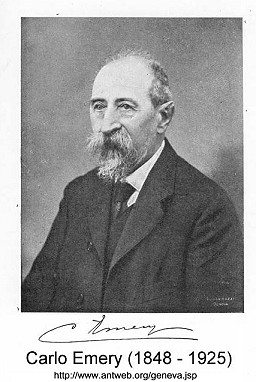 |
V Karavaiev 1864-1939 (also known as W
Karawaiew; 1911  ) reported primarily
collections from Sudan but gave some records from Cairo and Aswan, at
each end of the river journey, which seems to have begun in
mid-February and taken until the end of March. He noted temperature
readings in the Zoological Garden in Khartoum on 20 March to 3 April.
He left Sudan from Port Sudan. In identifying the ants he had help from
Dr F Santschi and Professor C Emery. ) reported primarily
collections from Sudan but gave some records from Cairo and Aswan, at
each end of the river journey, which seems to have begun in
mid-February and taken until the end of March. He noted temperature
readings in the Zoological Garden in Khartoum on 20 March to 3 April.
He left Sudan from Port Sudan. In identifying the ants he had help from
Dr F Santschi and Professor C Emery.
From Egypt, he listed - Messor aegyptiacus major and minor from
Cairo; Monomorium destructor (gracillimum) at Elephant
Is, Aswan; Monomorium salomonis from Aswan and the desert at
Giza; Monomorium nitidiventre from Aswan and Cairo; Tetramorium
caespitum at Cairo; Cardiocondyla mauritanica at Aswan
Municipal Garden; Tapinoma erraticum in Cairo; Paratrechina
jaegerskioeldi from Cairo (Marg & Gezire garden); Cataglyphis
lividus auratus at Aswan; Camponotus maculatus at Cairo; Camponotus
thoracicus var xerxes at Cairo. |
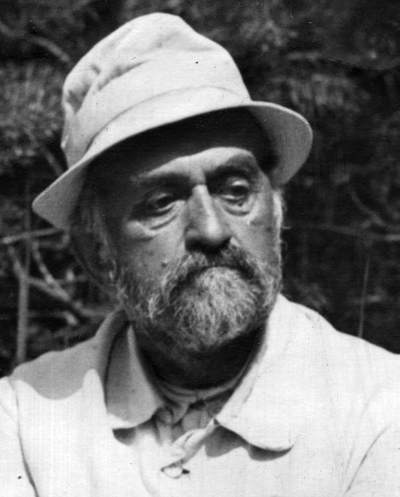
|
F Santschi (1912b  ) included
a description of Messor arenarius stirps thebaicus n
st, from Egypt, without locality, in Museum of Paris, collector Le
Tourneux. ) included
a description of Messor arenarius stirps thebaicus n
st, from Egypt, without locality, in Museum of Paris, collector Le
Tourneux. |
|
F Santschi (1915c  ) included
a description of a new species, Camponotus (Myrmotrema) rhamses
from "Haute-Égypte: lac No (Dr Reichensperger leg.), 2 workers";
specimens probably from the Paris Museum (location possibly Thebes -
the ruin of No-Amon?? - (25.7° N 32.645° E) - which fits with the
previous entry. ) included
a description of a new species, Camponotus (Myrmotrema) rhamses
from "Haute-Égypte: lac No (Dr Reichensperger leg.), 2 workers";
specimens probably from the Paris Museum (location possibly Thebes -
the ruin of No-Amon?? - (25.7° N 32.645° E) - which fits with the
previous entry. |
|
|
W.M. Wheeler & W.M. Mann (1916  ). The ants
of the Phillips expedition to Palestine during 1914. Bulletin of
the Museum of Comparative Zoology at Harvard College, 60,
167-174 - from Sinai were - Tetraponera bifoveolata var
syriaca at Wadi Gazelle; Messor rufotestaceus from
Wadi Gharandel; Messor concolor from Wadi Feran; Messor
aegyptiacus from Wadi Feran, Wadi Gazelle, Mt Sinai, also Cairo and
Fayum; Pheidole pallidula from Wadi Feran & Wadi Gazelle; Pheidole
sinaitica from Cairo; Crematogaster auberti ssp antaris
from Mt Sinai; Crematogaster inermis from Mt Sinai, Wadi
Gazelle & Wadi Feran; Monomorium niloticum from Wadi
Gazelle; Monomorium salomonis from Wadi Gharandel; Monomorium
nitidiventre from Cairo; Monomorium abeillei from Wadi
Feran & Wadi Gazelle; Tetramorium schmidti from Mt Sinai;
from Mt Sinai; Tetramorium punicum from Mt Sinai; Bothriomyrmex
syrius from Wadi Gazelle; Lepisiota carbonaria from Wadi
Gazelle; Plagiolepis pygmaea from Wadi Feran; Paratrechina
jaegerskioeldi from Cairo; Cataglyphis bombycinus from Lake
Fayum; Cataglyphis bombycinus sinaiticus from Wadi Gazelle; Cataglyphis
lividus from Wadi Gharandel; Cataglyphis niger from Cairo
& Lake Fayum; Cataglyphis nodus var orientalis from
Wadi Feran & Wadi Gharandel; Camponotus oasium from Wadi
Feran; Camponotus thoracicus var cypriacus from Wadi
Gharandel; Camponotus thoracicus var sanctoides from
Wadi Feran & Mt Sinai; Camponotus thoracicus var mortis
from Wadi Feran; and, Polyrhachis lacteipennis ssp simplex
from Wadi Feran. ). The ants
of the Phillips expedition to Palestine during 1914. Bulletin of
the Museum of Comparative Zoology at Harvard College, 60,
167-174 - from Sinai were - Tetraponera bifoveolata var
syriaca at Wadi Gazelle; Messor rufotestaceus from
Wadi Gharandel; Messor concolor from Wadi Feran; Messor
aegyptiacus from Wadi Feran, Wadi Gazelle, Mt Sinai, also Cairo and
Fayum; Pheidole pallidula from Wadi Feran & Wadi Gazelle; Pheidole
sinaitica from Cairo; Crematogaster auberti ssp antaris
from Mt Sinai; Crematogaster inermis from Mt Sinai, Wadi
Gazelle & Wadi Feran; Monomorium niloticum from Wadi
Gazelle; Monomorium salomonis from Wadi Gharandel; Monomorium
nitidiventre from Cairo; Monomorium abeillei from Wadi
Feran & Wadi Gazelle; Tetramorium schmidti from Mt Sinai;
from Mt Sinai; Tetramorium punicum from Mt Sinai; Bothriomyrmex
syrius from Wadi Gazelle; Lepisiota carbonaria from Wadi
Gazelle; Plagiolepis pygmaea from Wadi Feran; Paratrechina
jaegerskioeldi from Cairo; Cataglyphis bombycinus from Lake
Fayum; Cataglyphis bombycinus sinaiticus from Wadi Gazelle; Cataglyphis
lividus from Wadi Gharandel; Cataglyphis niger from Cairo
& Lake Fayum; Cataglyphis nodus var orientalis from
Wadi Feran & Wadi Gharandel; Camponotus oasium from Wadi
Feran; Camponotus thoracicus var cypriacus from Wadi
Gharandel; Camponotus thoracicus var sanctoides from
Wadi Feran & Mt Sinai; Camponotus thoracicus var mortis
from Wadi Feran; and, Polyrhachis lacteipennis ssp simplex
from Wadi Feran.
|
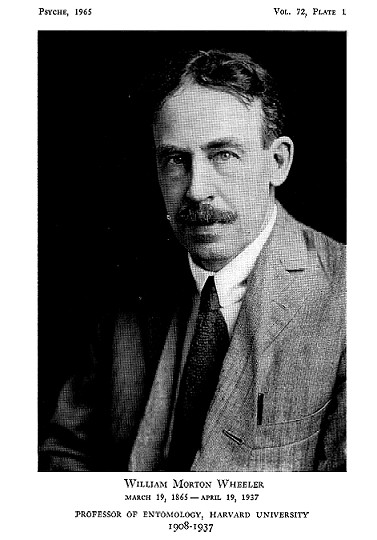
William Morton Wheeler was born March 19, 1865, Milwaukee; died April
19, 1937, Cambridge, Mass., U.S. American entomologist recognized as
one of the world's foremost authorities on ants and other social
insects. Two of his works, Ants: Their Structure, Development, and
Behavior (1910) and Social Life Among the Insects (1923),
long served as standard references on their subjects. http://www.nceas.ucsb.edu/~alroy/lefa/Wheeler.html
http://psyche2.entclub.org/articles/72/72-001.pdf |
|
H Viehmeyer 1868-1921 (1923). Wissenschaftliche Ergebnisse
der mit unterstützung der Akademie der Wissenschaften in Wien aus der
erbschaft treitl von F. Werner unternommenen Zoologischen
Expedition nach dem Anglo-Ägyptischen Sudan (Kordofan) 1914. 7.
Hymenoptera A. Formicidae. Denkschriften der Akademie der
Wissenschaften in Wien (Mathematisch-Naturwissenschaftliche Klasse),
98, 83-94 -  . Reports a
survey in Egypt, Cairo, Luxor, south into Sudan, by F Werner in 1914,
and lists 52 species or forms but nearly all from Sudan . Reports a
survey in Egypt, Cairo, Luxor, south into Sudan, by F Werner in 1914,
and lists 52 species or forms but nearly all from Sudan
The Egypt findings were - Messor medioruber and Monomorium
salomonis atrata from the Arabian Desert Mokattam near Cairo; Monomorium
destructor from Aswan; Lepisiota gracilicornis at Aswan; Cataglyphis
bicolor at Luxor and Aswan, Gizeh & Cairo; Cataglyphis
bombycinus at Abu Simbel and Wadi Halfa; Camponotus maculatus
at Cairo (in hotel); and, Campontous fellah from the Arabian
Desert Mokattam near Cairo.
|
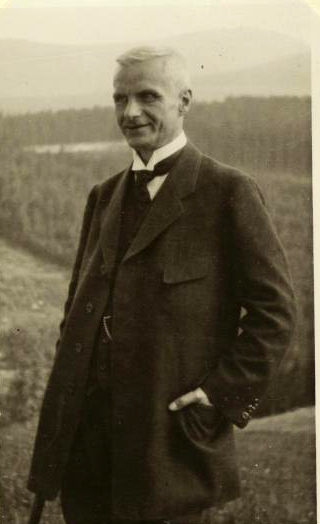
|
|
F Santschi (1928f  ) - had
solely a description of Messor rugosus new stirps crawleyi
from among the Hall material and listed in Alfieri (1931). ) - had
solely a description of Messor rugosus new stirps crawleyi
from among the Hall material and listed in Alfieri (1931).
|
|
|
A Alfieri (1931  ) described how W J Hall, as
entomologist in the Plant Protection section of the Ministry of
Agriculture organised a survey of ant species that might be affecting
plants by transporting Coccids and Aphids from plant to plant. Eight
teams were organised and sent to cover the whole country. After two
months work, thousands of ants, in 686 tubes, with information tickets
within were sent to W C Crawley at Holland Park (London). His
identifications revealed 23 species, most already known from Egypt.
Alfieri stated also that Felix Santschi had told of his intention to
make a monographic revsion of the ants of Egypt.(one already in
Santschi, 1928f). From Santschi (1938a) it seems that Alfieri also had
material collected in earlier years, as Santschi gave dates from early
1914 to 1923 among the collection details. ) described how W J Hall, as
entomologist in the Plant Protection section of the Ministry of
Agriculture organised a survey of ant species that might be affecting
plants by transporting Coccids and Aphids from plant to plant. Eight
teams were organised and sent to cover the whole country. After two
months work, thousands of ants, in 686 tubes, with information tickets
within were sent to W C Crawley at Holland Park (London). His
identifications revealed 23 species, most already known from Egypt.
Alfieri stated also that Felix Santschi had told of his intention to
make a monographic revsion of the ants of Egypt.(one already in
Santschi, 1928f). From Santschi (1938a) it seems that Alfieri also had
material collected in earlier years, as Santschi gave dates from early
1914 to 1923 among the collection details.
The species listed were - Monomorium nitidiventre, Monomorium
destructor (gracillimum); Monomorium pharaonis, Monomorium
salomonis sommieri, Monomorium subopacum, Cardiocondyla
emeryi mahdii, Crematogaster inermis, Pheidole jordanica,
Pheidole teneriffana, Messor arenarius, Messor
aegyptiacus, Messor structor, Messor rugosus crawleyi,
Tetramorium punicum, Tapinoma erraticum, Plagiolepis
pygmaea, Paratrechina jaegerskioeldi, Paratrechina
longicornis, Cataglyphis lividus, Cataglyphis bicolor,
and, Camponotus aegyptiacus.
|
|
|
Carlo Menozzi 1892-1943 (1929e,  ). Formiche
del Sinai, raccolte dal Dr. F. S. Bodenheimer, con descrizione
di una nuova specie di Monomorium del sottogenere Equestrimessor.
Pages 125-128 in Bodenheimer, F. S. and O. Theodor. Ergebnisse der
Sinai-Expedition 1927 der Hebraeischen Universitaet, Jerusalem,
Leipzig. 142 pp. ). Formiche
del Sinai, raccolte dal Dr. F. S. Bodenheimer, con descrizione
di una nuova specie di Monomorium del sottogenere Equestrimessor.
Pages 125-128 in Bodenheimer, F. S. and O. Theodor. Ergebnisse der
Sinai-Expedition 1927 der Hebraeischen Universitaet, Jerusalem,
Leipzig. 142 pp.
The species listed were Messor foreli, Pheidole
jordanica, Crematogaster (Cr.) jehovae, Crematogaster
(Cr.) inermis, Monomorium venustum, Monomorium salomonis
sommieri, Monomorium bodenheimeri (nsp), Lepisiota nigra,
Camponotus (Tanaemyrmex) fellah, Polyrhachis
lacteipennis, Cataglyphis lividus, Cataglyphis niger
& Cataglyphis nodus.
Primarily publishing from 1918 (under name
C Minozzi, from Modena) to 1942 (C Menozzi, Ferrara), with a joint
paper (apparently posthumous) with M Consani in 1952. His papers do not
give an address other than an Italian place name; also Chiavari.
|

|
|
F Santschi (1934d  ) In
July-August 1933, Santschi took a short cruise in the eastern
Mediterranean. amomg the stopping places was Alexandria. He collected
in the public gardens on 8 August 1933, finding Pheidole teneriffana
and Paratrechina jaegerskioeldi. ) In
July-August 1933, Santschi took a short cruise in the eastern
Mediterranean. amomg the stopping places was Alexandria. He collected
in the public gardens on 8 August 1933, finding Pheidole teneriffana
and Paratrechina jaegerskioeldi.
|
|
|
B Finzi 1897-1941 (1936  ). in the "Risultati
scientifici della spedizione di S.A.S. il Principe Alessandro della
Torre e Tasso nell'Egitto e Penisola del Sinai" reported collections
made in a widespread survey by A. Schatzmayr, K. Koch and W. Wittmer.
Finzi tabulated 80 forms,including varieties and subspecies; the lists
are at species 1-40
and species 41-80. ). in the "Risultati
scientifici della spedizione di S.A.S. il Principe Alessandro della
Torre e Tasso nell'Egitto e Penisola del Sinai" reported collections
made in a widespread survey by A. Schatzmayr, K. Koch and W. Wittmer.
Finzi tabulated 80 forms,including varieties and subspecies; the lists
are at species 1-40
and species 41-80.
Modern names are - 1. Hypoponera ragusai; 8. Messor
aegyptiacus sahlbergi; 9 probably Messor aegyptiacus; 12. Messor
maculifrons; 13. Messor ebeninus; 29. Monomorium
niloticum; 39. Monomorium destructor; 43. Nesomyrmex
angulatus; 46. Tetramorium taueret; 48. Tetramorium
sahlbergi; 49. Pyramica (Trichoscapa) membranifiera; 51. Plagiolepis
ancyrensis; 52. Plagiolepis maura; 53. Lepisiota
frauenfeldi aegyptiaca; 54. Lepisiota syriaca; 55. Lepisiota
nigra; 56. Lepisiota splendens; 57. Lepisiota
frauenfeldi opaciventris; 58. Lepisiota gracilicornis; 59. Camponotus
(Tanaemyrmex) fellah; 60. Camponotus (Tanaemyrmex) thoracicus;
61. Camponotus (Tanaemyrmex) aegyptiacus; 69. Cataglyphis
lividus; 70. Cataglyphis lividus ambigua; 71. Cataglyphis
albicans auratus; 73. Cataglyphis savignyi; 74. Cataglyphis
desertorum; 75. Cataglyphis niger; 76. Cataglyphis isis;
75. Cataglyphis niger pharao; 79. Cataglyphis bombycinus;
80. Cataglyphis bombycinus sinaiticus.
|

|
|
F Santschi (1938a  ) "Quelques
nouvelles fourmis d'Egypte", gave further results, with some new forms,
from the Alfieri survey of 1925 and other collections (*denoted as
already known but new to Egypt) new forms)- Dorylus (T.) fulvus
rufescens from 3 locations; Aenictus fuscovarius st sagittarius
nov. from Dakhla Oasis (coll Stoney) and Dorr (coll
Adair); Messor ebeninus from Wadi Tamanid; Messor
aegyptiacus from four locations; Messor foreli from Bir
Sheftun, "arabian desert north Nag-Hamadi"; Messor fellah from
three locations; Messor rufotestaceous from Wadi Hof; Messor
arenarius st alfieri nov from Medai, Cairo (coll A
Borcard), Mariout (coll Storey) and Alexandria; Messor arenarius
var diabolus nov from El Arich, Sinai (coll Graves); Messor
arenarius st thebaicus from three locations*; Messor
niloticus sp nov from Mariout (no details, 10.iii.1914); Aphaenogaster
splendida from Cairo*; Pheidole teneriffana from Ghezireh
and Giza; Pheidole sinaitica from Meadi & Mariout; Crematogaster
(Cr.) auberti nigripes from 6th Tower, Suez Roda & Dekhelia; Crematogaster
(Cr.) jehovae from Alfia; Crematogaster (Cr.) inermis from
Hammam (coll Mariout) & Nag-Hamadi (coll Storey); Crematogaster
(Cr.) inermis ssp lucida from Wadi Hof, Embabaa &
Ras-el-Bar*; Monomorium destructor (gracillimum) from
several locations; Monomorium nitidiventre from Ghezireh &
Giza; Monomorium salomonis from Meadi; Monomorium
areniphilum fezzanensis from Wadi Hof*; Monomorium pharaonis
from Ghezireh; Nesomyrmex angulatus (Leptothorax angulatus)
from Cairo; Tapinoma simrothi var phoenicum from Cairo;
Plagiolepis pallescens var isis nov from
Ghezireh; Camponotus aegyptiacus from many locations; Camponotus
aegyptiacus var hyskos nov from Cairo (A Borcard); Camponotus
thoracicus var delta nov from Mariout; Camponotus
thoracicus var herodes nov from five locations; Camponotus
fellah from six locations; Camponotus (Myrmosericus) micans
one male from Salkoum; Camponotus (Orthonotomyrmex) sericeus
from Wadi Tawadid (SE Mersa Matrouh) & Dakla Oasis; Paratrechina
longicornis from Ismailia; Paratrechina jaegerskioeldi from
farms and gardens in several locations; Cataglyphis aenescens,
one worker from Wadi Digila *[Santschi noted first finding in Egypt but
the type location is Russia (Balkans) and his identification may be
questionable); Cataglyphis bombycinus from nine locations; Cataglyphis
albicans ssp opacus from Wadi Hof*; Cataglyphis lividus
ssp ambigua from 7th Tower, Suez Road; Cataglyphis albicans
ssp arenaria from Wadi Assiuti*; Cataglyphis bicolor
ssp oasium from Meadi*; Cataglyphis desertorum from
five northern locations; Cataglyphis savignyi from Salloum,
Cairo & Suez; Cataglyphis niger ssp pharao from
Wadi Assiuti & Kafr Hakim. ) "Quelques
nouvelles fourmis d'Egypte", gave further results, with some new forms,
from the Alfieri survey of 1925 and other collections (*denoted as
already known but new to Egypt) new forms)- Dorylus (T.) fulvus
rufescens from 3 locations; Aenictus fuscovarius st sagittarius
nov. from Dakhla Oasis (coll Stoney) and Dorr (coll
Adair); Messor ebeninus from Wadi Tamanid; Messor
aegyptiacus from four locations; Messor foreli from Bir
Sheftun, "arabian desert north Nag-Hamadi"; Messor fellah from
three locations; Messor rufotestaceous from Wadi Hof; Messor
arenarius st alfieri nov from Medai, Cairo (coll A
Borcard), Mariout (coll Storey) and Alexandria; Messor arenarius
var diabolus nov from El Arich, Sinai (coll Graves); Messor
arenarius st thebaicus from three locations*; Messor
niloticus sp nov from Mariout (no details, 10.iii.1914); Aphaenogaster
splendida from Cairo*; Pheidole teneriffana from Ghezireh
and Giza; Pheidole sinaitica from Meadi & Mariout; Crematogaster
(Cr.) auberti nigripes from 6th Tower, Suez Roda & Dekhelia; Crematogaster
(Cr.) jehovae from Alfia; Crematogaster (Cr.) inermis from
Hammam (coll Mariout) & Nag-Hamadi (coll Storey); Crematogaster
(Cr.) inermis ssp lucida from Wadi Hof, Embabaa &
Ras-el-Bar*; Monomorium destructor (gracillimum) from
several locations; Monomorium nitidiventre from Ghezireh &
Giza; Monomorium salomonis from Meadi; Monomorium
areniphilum fezzanensis from Wadi Hof*; Monomorium pharaonis
from Ghezireh; Nesomyrmex angulatus (Leptothorax angulatus)
from Cairo; Tapinoma simrothi var phoenicum from Cairo;
Plagiolepis pallescens var isis nov from
Ghezireh; Camponotus aegyptiacus from many locations; Camponotus
aegyptiacus var hyskos nov from Cairo (A Borcard); Camponotus
thoracicus var delta nov from Mariout; Camponotus
thoracicus var herodes nov from five locations; Camponotus
fellah from six locations; Camponotus (Myrmosericus) micans
one male from Salkoum; Camponotus (Orthonotomyrmex) sericeus
from Wadi Tawadid (SE Mersa Matrouh) & Dakla Oasis; Paratrechina
longicornis from Ismailia; Paratrechina jaegerskioeldi from
farms and gardens in several locations; Cataglyphis aenescens,
one worker from Wadi Digila *[Santschi noted first finding in Egypt but
the type location is Russia (Balkans) and his identification may be
questionable); Cataglyphis bombycinus from nine locations; Cataglyphis
albicans ssp opacus from Wadi Hof*; Cataglyphis lividus
ssp ambigua from 7th Tower, Suez Road; Cataglyphis albicans
ssp arenaria from Wadi Assiuti*; Cataglyphis bicolor
ssp oasium from Meadi*; Cataglyphis desertorum from
five northern locations; Cataglyphis savignyi from Salloum,
Cairo & Suez; Cataglyphis niger ssp pharao from
Wadi Assiuti & Kafr Hakim.
|
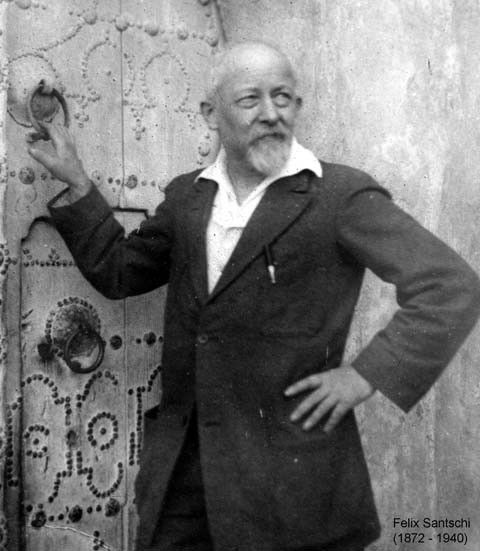 |
F Santschi (1938c) Mission Robert
Ph. Dollfus en Égypte. Hymenoptera: Formicidae. Mémoires de
l'Institute d'Égypte, 37, 253  - -
Camponotus aegyptiacus from a house in Cairo; Cataglyphis
bicolor from the beach at Mersa tal Kad Yayah (Sinai); Crematogaster
inermis on the shore at Sheikh Riyah (Sinai); Paratrechina
longicornis at Port Tewfiq, Suez, many in a laboratory. |
|
|
H Donisthorpe (see http://www.absoluteastronomy.com/encyclopedia/h/ho/horace_donisthorpe.htm)
Donisthorpe (1939a  ) - Cerapachys longitarsus synonyms
cooperi and alfieri, collectors J
Omer-Cooper (1935) and the Hall survey/A Alfieri (1925). ) - Cerapachys longitarsus synonyms
cooperi and alfieri, collectors J
Omer-Cooper (1935) and the Hall survey/A Alfieri (1925).
The main report was in Donisthorpe (1942a  ), "The Formicidae (Hym.) of the Armstrong
College expedition to the Siwa Oasis" which lists 26 forms collected by
J Omer-Cooper in July-August 1935. A second report
was by Donisthorpe (1947e ), "The Formicidae (Hym.) of the Armstrong
College expedition to the Siwa Oasis" which lists 26 forms collected by
J Omer-Cooper in July-August 1935. A second report
was by Donisthorpe (1947e  ). ).
For Siwa information visit http://www.egyptvoyager.com/oases_siwa.htm
Portrait from http://www.answers.com/topic/horace-donisthorpe
|
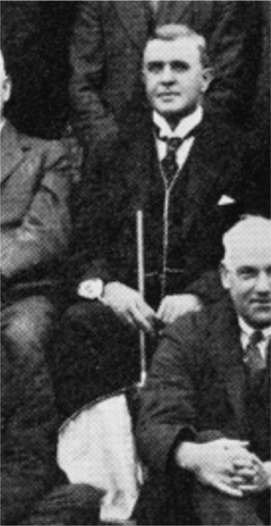
|
A H Mohamad (1979) unpublished PhD
thesis - "Taxonomic studies on family Formicidae (Hymenoptera) in A.R.
Egypt". Entomology Department, Faculty of Science, Ains Shans
University, 288 pp. According to Mohamed et al (2001), this
study was of "the Western Desert oasis and the Red Sea region".
SUMMARY
This systematic study was carried out to determine the recent status of
the genera and species belonging to family Formicidae in Egypt. This
study dealt with the morphological characters such as the number of
palp joints, shape of the clypeus, mandibles, shape and comparative
length of the antennal joints, shape of the thorax, petiole,
postpetiole, spurs of the middle and hind tibiae, and the venations of
the wings. Comparative studies, detailed plates of different parts of
the ant's body, keys and systematic descriptions were arranged for the
determination of these homogenous species. In this study, synonyms and
determinations, localities and geographic distribution are given for
the species, subspecies and varieties - some of which are not
represented in the collections of Egypt - under 22 genera following
five important subfamilies: Ponerinae, Dorylinae, Dolichderinae,
Formicinae and Myrmicinae. One genus from the subfamily ponerinae:
Genus Ponera; Two genera from the subfamily Dorylinae: genus Dorylus
and genus Aenictus. Two genera from the subfamily
Dolichoderinae: genus Tapinoma and genus Dolichoderus.
Seven genera from the subfamily Formicinae: genus Lasius, genus
Plagiolepis, genus Acantholepis (Lepisiota),
genus Cataglyphis, genus Camponotus, genus Paratrechina
and genus Polyrhachis. Ten genera from the subfamily
Myrmicinae: genus Aphaenogaster, genus Messor, genus Pheidole,
genus Monomorium, genus Tetramorium, genus Leptothorax,
genus Cardiocondyla, genus Crematogaster, genus Strumigenys,
and genus Solenopsis. There are 141 species, subspecies and
varieties recorded from Egypt, of which 79 are present in collections
in A.R. Egypt while 62 were recorded in the literature with no
representatives in the collections. From 79 species, 55 species are
intercepted from A.R. Egypt.
Most of the distribution recprds have been incorporated in this website |
|
Mohamed, S., Zalat, S., Fadl, H.,
Gadalla, S. & Sharaf, M. 2001.Taxonomy of ant species
(Hymenoptera: Formicidae) collected by pitfall traps from Sinai and
Delta Region, Egypt. Species found were * = new to Egypt
Tapinoma simrotthi, Camponotus oasium, Camponotus
thoracicus, Cataglyphis lividus, *Cataglyphis minimus,
Cataglyphis niger, Catglyphis ruber, Cataglyphis
sinaitica, Lepisiota nigra, Paratrechina jaegerskioeldi,
Plagiolepis maura, *Aphaenogaster phillipsi, *Aphaenogaster
syriaca, Cardiocondyla nuda, *Cardiocondyla wroughtonii,
Crematogaster aegyptiaca, Messor ebeninus, Messor
foreli, Messor rufotestaceus, *Monomorium carbonarium,
Monomorium niloticum, Pheidole jordanica, Pheidole
pallidula, Pheidole sinaitica, *Tetramorium brevicorne,
*Tetramorium depressiceps, and,Tetramorium salwae sp nov. |
M.Sc - Mostafa R. Sharaf. (2001) Biodiversity,
taxonomic studies and gamma radiation effect on ants species
(Formicidae: Hymenoptera) in two governorates (Dakahliya and South
Sinai). Summary of the Ecology part: The ant community
prevailing in South Sinai and Dakhlyia governorates were inventoried at
30, 90, 900, 1620, and 1650 m. a. s. l. using 220 pitfall traps over a
period of one year from March 1998 to February 1999 at eleven sites
arranged in four different altitudinal regions, includes 27 species
under 13 genera belonging to 3 subfamilies. In general, the species
diversity was high at both low and high elevations represented by Wadi
El-Arbaein, El-Mafareq , El-Mansoura, and Wadi El-Talaa, while it was
relatively low at mid-elevations represented by Sahab. The similarity
indices indicate that, its values were similar between adjacent
elevations (1620 and 1650 m. a. s. l.) represented by Wadi El-Arbaein
and Wadi El-Talaa respectively, and it was low between the agricultural
ecosystems represented by El-Mansoura and the other desert ecosystem
sites of South Sinai governorate. In brief, elevation and vegetation
were the most important factors affecting the diversity, abundance and
distribution of ant species in South Sinai and Dakhlyia governorates. |
El-Moursy, A., El-Hawagry, Abdeldayem,
M. & Fadl, H. 2001. Insect diversity in Zaranik Protectorate,
northern Sinai, Egypt,
Species found were * = new to Egypt
Camponotus maculatus, Camponotus oasium, Cardiocondyla
sp 1, Cardiocondyla sp 2, * Cataglyphis diehlii, Cataglyphis
lividus, Cataglyphis niger, Crematogaster aegyptiacus,
Messor aegyptiacus, Messor ebeninus, *Monomorium
carbonarium, Monomorium niloticum, * Pheidole katonae,
and Pheidole sp. |
|
This website has records of ant species
collected in the St Katharine's Protectorate, Sinai, by Mike James, as
part of a study on the Sinai Baton Blue Butterfly. These are - * new to
Egypt
Camponotus aegyptiacus, Camponotus
(Myrmosericus) cruentatus, Tapinoma simrothi, Plagiolepis
maura, Cataglyphis niger, Cataglyphis ruber, *Lepisiota
canescens, *Lepisiota gracilicornis, *Lepisiota hirsuta,
*Lepisiota obtusa, *Monomorium sp nov?; Tetramorium
schmidti, and Crematogaster antaris |
|
Sharaf, M. R. 2006. Taxonomic
and Ecological studies on family Formicidae (Order: Hymenoptera) in
Egypt including some protectorates with a study of some insect fauna
associated with ant species. Faculty of Science, Ain Shams
University, Entomology Dep. Cairo, Egypt. (unpublished thesis), 340 pp.
Summary * new to Egypt
Twenty four genera belonging to eight subfamilies Aenictinae,
Dorylinae, Myrmicinae, Pseudomyrmicinae, Ponerinae, Cerapachyinae,
Formicinae, Dolichderinae are recognized, of which 123 species and 24
subspecies appear to be present in Egypt; A full synonymy is attempted
for each species with appropriate literature. Keys are provided to all
the Egyptian subfamilies, genera and species to enable the
identification of the workers of all Egyptian ants. A total of 146
species and subspecies in twenty four genera are recognized, all of
them are diagnosed and seven of which are Cerapachys collingwoodi;
Cataglyphis agostii; Messor eglalae; Monomorium
dentatum; Pheidole fadli; Solenopsis bakri and Tetramorium
shirlae are described as new, moreover, eleven species *Plagiolepis
schmitzii Forel, 1895, 1881; *Cardiocondyla israelica
Seifert, 2003; *Cardiocondyla minutior Forel, 1899; *Monomorium
exiguum Forel, 1894; *Monomorium jizane Collingwood &
Agosti, 1996; *Oxyopomyrmex santschii Forel, 1904; *Pheidole
katonae Forel, 1907; *Tetramorium bicarinatum
(Nylander,1846); *Tetramorium lanuginosum Mayr, 1870; *Tetramorium
shirlae Collingwood & Sharaf (in press); *Hypoponera
punctatissima (Roger, 1859) are recorded for the first time from
Egypt. Furthermore, Cardiocondyla minutior Forel, 1899 is
recorded for the first time from the whole palaearctic region. In
addition, the genus Oxyopomyrmex is a new record for the
Egyptian ant fauna, it is represented by O. santschii Forel,
1904. Local and world distribution are given for each species as well
as 157 figures of taxonomic characters are presented. In addition a
glossary of anatomical and other specialized terms used in ant taxonomy
are presented. Measurements useful for recognition of different species
and diagnosis of different castes as queens and males of many species
are given for the first time.
|

Mostafa Sharaf co-author of this website. |
| Brian Taylor holds the degrees of
Bachelor of Technology in Applied Biology (1966) and Doctor of
Philosophy in Biology (1969) from Brunel University, where he was the
first to gain the latter degree. After being a Licentiate (1962), then
Member (1969), he is now a Fellow (1990) of the Institute of Biology,
and a Chartered Biologist. Since 1972, he has been a Fellow of The
Royal Entomological Society of London. Now retired, his post-doctoral
career took him around the world, tackling problems and investigations
in applied biology. Although entomology was predominant among most of
those tasks, he always adopted a multi-disciplinary approach and the
human and wider ecosystems were never ignored. Similarly, pragmatism
and a concept of sensible economics were prime considerations. In later
years, project and organisational management were at the forefront and
he has taken a keen interest in the application of IT from its outset
as a practical tool. The width and variety of his work can be seen from
the list of selected publications http://www.antbase.org/ants/africa/personal/btpubs.htm,
many of which are analytical and several have been widely cited. The
change of behaviour findings for Anopheles farauti have passed
into the "folk-lore" of malaria and its vectors. Similarly, his work on
strategic timing of insecticide applications for the control of Yellow
Stem Borer was at the forefront of Integrated Pest Management in rice.
He lived and worked in the Solomon Islands, Nigeria, Bangladesh,
Tanzania and Malawi, as well as conducting field trials of 2-3 months
duration in Sudan, El Salvador and Colombia. His involvement in
international development demanded much in the way of hands-on training
and four of his "counterparts" went on to gain PhD degrees. Public
Relations and extension activities were essential elements, with much
of his work being on-farm and demanding full cooperation from local
people. On a wider field, in 1985-87, he led a major Environmental
Education and Interpretation Team in Derbyshire. The present
"electronic publications" stem from his interest in IT and its use in
the data-handling and analysis, in cataloguing and in the spread of
knowledge. That interest has matched his long-held desire to make
fuller use of the great amount of information on ants which he gained
while investigating the dissemination of Phytophthora disease
of cocoa in Nigeria (1974-76), on deepwater rice and its pests in
Bangladesh (1981-83), on the upland "cooking" bananas of East Africa
(1987-90), on anti-malaria operations in the Solomons (1969-73) and,
last but not least, to develop ideas germinated in the late-1960's as
to how the innate system of activity timing might operate. |
 Brian Taylor -
originator and co-author of this website and author of Ants of
(sub-saharan) Africa Brian Taylor -
originator and co-author of this website and author of Ants of
(sub-saharan) Africa |
Historic portraits from http://cos-server.marshall.edu/euscorpius/images/memorial_gallery.htm
|
|
|